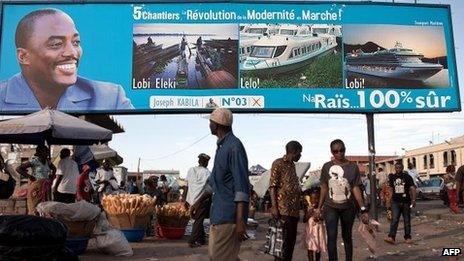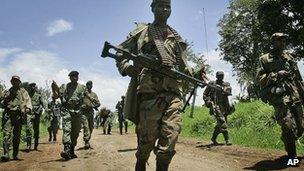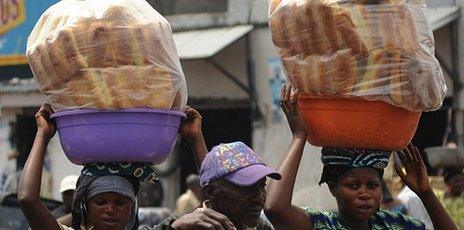Joseph Kabila: DR Congo's president in profile
- Published

Joseph Kabila campaigned for his second term in office as leader of the Democratic Republic of Congo with the slogan "for a united Congo".
But his victory, with 49% of the vote, underlies the tensions in the vast and chaotic country.
At 40, he is nearly half the age of his main rival Etienne Tshisekedi, who took 32% of the vote mainly in the west of country.
President Kabila enjoys most of his support in the east, where he was born in a rebel camp in the mountain forests where his father was leading the struggle against former strongman Mobutu Sese Seko.
He was a low-profile military commander when his father Laurent-Desire Kabila was assassinated in 2001, and was handpicked by the presidential inner circle to lead DR Congo as it was being torn apart by half a dozen warring armies.
Many opposition activists accused him, without proof, of being a national of neighbouring Rwanda, which had twice invaded its much larger neighbour.
Mr Kabila spent his childhood in Tanzania and spoke better kiSwahili and English than the languages most spoken in Kinshasa - French and Lingala, which he had to learn on the job.
Winning DR Congo's first democratic elections in more than 40 years at the tender age of 35 gave him the legitimacy to stamp his authority on the country and move out of his father's shadow.
'Debt to pay'
But he tends to keep a low profile, shying away from public speaking.

Armed men have for years terrorised the east of the country
"Kabila is not shy, he is reserved. This is part of his Swahili cultural background," said his one-time personal secretary, Kikaya Bin Karubi, who is now DR Congo's ambassador in the UK.
This reservation is in sharp contrast to the usual Congolese effusiveness.
His smiling face, however, has been seen all over the country in the last few weeks, beaming down from huge advertising hoardings.
His campaign has been built around what he has called the "five building sites of the republic": Infrastructure; health and education; water and electricity; housing and employment.
Eight years after the end of the war, many Congolese complain that the pace of social development is too slow.
His power base of eastern DR Congo bore the brunt of the fighting during the civil war, which drew in other countries including Uganda and Rwanda.
Rebels and militias still roam the area despite attempts by the UN and army to disarm them, earning money from the area's rich mineral wealth.
The army itself has been accused of human rights abuses and profiteering.
DR Congo holds more than half of the world's cobalt, 30% of all diamonds, 70% of coltan - a vital ingredient in mobile phones - as well as huge deposits of gold, copper and various other minerals.
However, this year's UN human development index placed DR Congo bottom of the 187 countries surveyed.
The president has acknowledged the shortcomings, saying on the campaign trial that he had a debt to settle with Congolese voters, so they should give him another term to let him repay it.
'War bus'
According to Mr Bin Karubi, Mr Kabila often relaxes at weekends on his farm on the outskirts of Kinshasa, where he enjoys motorcross.
Just before the 2006 elections, Mr Kabila married his long-time girlfriend Olive Lembe di Sita. The couple have a daughter, Sifa born in 2001, and a son, Laurent-Desire, named after Mr Kabila's mother and father respectively.
His schoolmates at the Zanaji secondary school in Dar es Salaam nicknamed him "War bus" because of his enjoyment of war films and martial arts.
Still, they were all surprised when they saw the first pictures of him and his father fighting a real war, which ended when they seized power in DR Congo (then Zaire) and overthrew Mobutu in May 1997.
Correspondents say in order to avoid the attentions of Mobutu's intelligence service, he grew up in Tanzania pretending to be a member of the country's Fipa ethnic group.
"We didn't even know he was Congolese," recalls one of his contemporaries, who did not want to be named.
With his father installed as DR Congo's leader, Joseph Kabila was sent to China for military training and became army chief of staff before inheriting the presidency.
His experience as a general in the Congolese army helps him to keep direct control over an estimated 7,000-strong army unit known as the Republican Guard.

DR Congo came last in the UN's index of human development
The five-year civil war led to shady business deals to mine its rich resources, but Mr Kabila has not been directly implicated in any.
The same cannot be said of "the Kabila boys", his close circle of advisers.
One of them, Katumba Mwanke, a minister at the presidency, was forced to resign because of accusations in a 2002 United Nations report that he was profiteering from the war through deals made with Zimbabwean officials.
With a second term in office, Mr Kabila has an opportunity to capitalise on cleaning up the mining sector.
He will also be keen to see the departure of the 19-000 strong UN mission in DR Congo, Monusco, within the next five years.
But his biggest challenge will be keeping a lid on the violence, with opposition supporters crying foul over the election results about allegations of vote-rigging.





